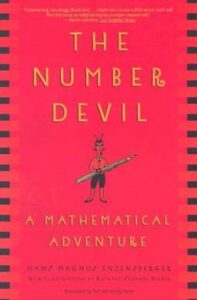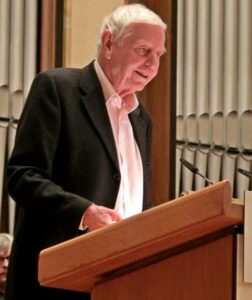The Number Devil
The Number Devil: A Mathematical Adventure is a fictional book for children and young adults, published in 1997. It was written by German author Hans Magnus Enzensberger, illustrated by Rotraut Susanne Berger, and translated into English by Michael Henry Heim.
The book explores concepts in mathematics, embedded within a story about a twelve-year-old boy, Robert. It is split into twelve chapters, roughly corresponding to twelve nights in which Robert dreams about his encounters with the Number Devil, a little red man with a beard, devil’s horns, and a rather ill temper. The Number Devil has an extensive mathematical knowledge and guides Robert through the wonderous world of numbers and mathematical ideas.
Robert initially hates mathematics and his maths teacher Mr. Bockel (which literally translates to ‘stubborn goat’ in German), but throughout the story, he becomes more and more comfortable with the subject. The book ends with Robert sitting in Mr. Bockel’s class and surprisingly finding a rapid way to solve a maths problem.

Image credit: St. Martin’s Press, fair dealing via Wikimedia Commons.
Devilish Mathematics
What makes Enzensberger’s book appealing to a non-specialist audience is his playful portrayal of mathematics through imaginative names. For example, he refers to Georg Cantor as Professor Singer (‘Kantor’ means ‘singer’ in German), and Leonard Euler as an owl (‘Eule’ in German).
Additionally, exponentiation is called ‘hopping’, irrational numbers are ‘unreasonable’ numbers, and prime numbers are ‘prima donnas’ (divas).

Image credit: Rotraut Susanne Berger, fair dealing via Wikimedia Commons.
The mathematics in the book is explained through dream-like settings: In a forest made out of trees that are big 1’s, the Number Devil introduces roman numerals; in a sand desert, they find a palm tree with coconuts to lay out number triangles; and Fibonacci numbers (‘Bonacci numbers’ in Enzensberger’s terminology) are demonstrated by quickly multiplying rabbits.
Through engaging illustrations and simple explanations, the reader can discover exciting mathematical ideas without ever solving a single problem or equation.
At one point, the Number Devil interestingly states that “proof is everything”, despite hardly ever proving any of the concepts he teaches Robert. For example, when introducing prime numbers, he explains the famous Goldbach Conjecture, asserting that between any number larger than one and twice that number, there is a ‘prima donna’ – selling it as a mathematical fact, despite there being to mathematical proof!
A digitalised version of Enzensberger’s book with all mathematical explanations and illustrations can be found here.
About the Author
Hans Magnus Enzensberger was a German writer and scholar, but no mathematician. Born in 1929 in Kaufbeuren, he studied literature and philosophy in Erlangen, Freiburg, Hamburg, and Paris, published more than 70 books, spoke several languages and lived in multiple countries.
Additionally, Enzensberger had several wide-ranging interests, including a passion for mathematics. He criticised the isolation of the subject from society and dedicated The Number Devil to his eleven-year-old daughter, Theresia, who struggled with some of the mathematical concepts explained in the book.
Enzensberger died on 24 November 2022 in Munich, aged 93.

Image credit: Felix König, CC BY 3.0 DEED, via Wikimedia Commons.
The Number Devil and Society
In his book, Enzensberger not only simplifies increasingly complex mathematical concepts for young audiences, but also criticises the role of mathematics in society.
Robert represents the typical middle-school-student who fails to see how mathematics relates to his life. This reflects many students’ experiences with mathematics at school, where traditional textbook teachers like Mr. Bockel convey the material without much enthusiasm.
The Number Devil, on the other hand, portrays a more passionate mentor who is interested in the subject but often becomes frustrated with his students’ inability to grasp complex concepts. Through his guidance, it becomes clear that school is not where one learns ‘real mathematics’, criticising both the teaching of the subject and the teachers themselves.
This may be seen as a very harsh view, and while receiving mostly positive reviews, some critics have taken issue with some aspects of Enzensberger’s story.
One such criticism is that, The Number Devil appears to portray an image of mathematics as a ‘secret club’, depending on the inside expertise of some few individuals (number devils), and restricted to privileged access (the Number Devil invites Robert to join).
A second point of critique is that the book is all-male. Maybe it would have been a good idea to make Robert a female student who gains interest in mathematics, giving some encouragement to aspiring female mathematicians. Furthermore, the sole female character in the story is Robert’s mother, who plays the stereotypical role of a woman acting ignorantly towards mathematics and struggles to understand her child’s intellectual curiosities. Letting her represent someone who clearly is not a part of this ‘exclusive’ mathematical world does not reflect well on the portrayal of gender roles in this story – especially since it was written for Enzensberger’s daughter, Theresia.
Reception
The Number Devil may not be as suitable for children as initially intended. However, most critics recommend the book as a great learning tool for students who already hold some background mathematical knowledge, or for younger children who could read it with a more experienced adult’s guidance.
Enzensberger’s story is often compared to other books like Alice in Wonderland or Flatland: A Romance of Many Dimensions due to their common portrayal of mathematics in literature. It is a great example of engaging a wider audience with mathematical concepts by integrating them into a fictional story and simultaneously reflecting social issues. That way, Enzensberger makes it easy for the reader to relate with Robert and his struggles, whilst progressively introducing him to new concepts, making him and the reader more and more comfortable with mathematics.
Author
Isabel Kestler

